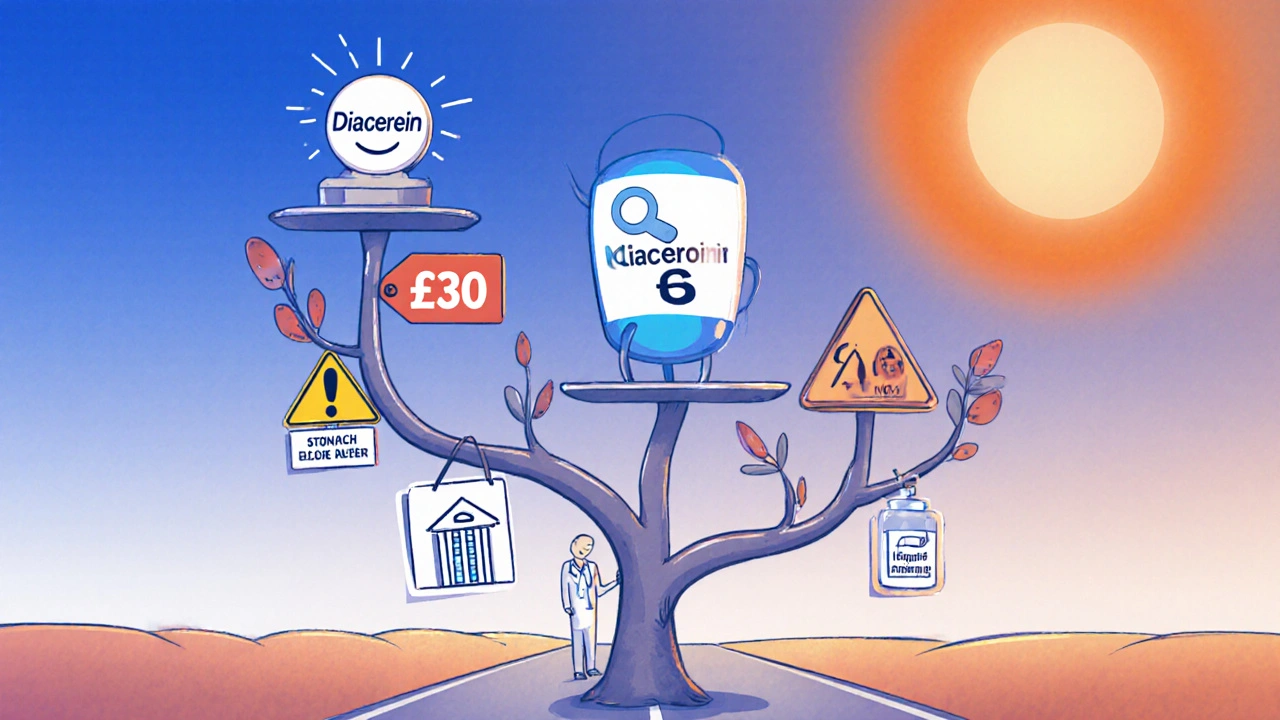Diacerein vs Other Osteoarthritis Options: Detailed Comparison of Benefits, Risks & Alternatives

Osteoarthritis Treatment Selector
This tool helps you identify the most suitable osteoarthritis treatment option based on your specific priorities and medical history. Answer a few questions to see which treatments align with your needs.
Select how quickly you need pain reduction. Diacerein works slowly, while NSAIDs provide faster relief.
If you have stomach issues or history of ulcers, select this as important.
Consider the monthly cost of treatment options.
Do you prefer oral medications over injections?
Living with osteoarthritis often feels like a constant battle between pain relief and side‑effects. While NSAIDs dominate the market, many patients and clinicians are looking for safer, disease‑modifying options. This guide breaks down diacerein and stacks it against the most common alternatives, so you can see which choice fits your health goals.
What is Diacerein?
Diacerein is a disease‑modifying osteoarthritis drug (DMOAD) that aims to slow cartilage breakdown rather than just mask pain. It was first approved in Europe in the late 1990s and works by inhibiting the enzyme interleukin‑1 beta, a key player in inflammation and cartilage degradation.
How Diacerein Works
The drug reduces the production of inflammatory cytokines and matrix‑metalloproteinases, both of which chip away at cartilage. By tempering these processes, diacerein can preserve joint structure over time, offering a modest slowing of disease progression.
Clinical Evidence and Safety Profile
Large‑scale European trials (e.g., the European Study on Diacerein in Osteoarthritis) showed that patients on 50 mg twice daily experienced a 10‑15 % improvement in pain scores compared with placebo after 12 months. Radiographic data suggested a slight reduction in joint‑space narrowing, though effects are less dramatic than those seen with joint replacement.
Side‑effects are mostly gastrointestinal - loose stools and mild abdominal discomfort are the most reported. Rarely, liver enzyme elevations occur, so routine blood monitoring is advised, especially in patients with pre‑existing liver disease.
Common Alternatives Explained
Before you decide, it helps to know the landscape of other options.
- NSAIDs (non‑steroidal anti‑inflammatory drugs) are the first‑line analgesics for osteoarthritis, acting by blocking cyclooxygenase enzymes to reduce prostaglandin‑mediated pain and inflammation.
- Glucosamine is a natural amino‑sugar often marketed as a supplement that may support cartilage repair, though clinical results are mixed.
- Hyaluronic Acid injections (viscosupplementation) aim to improve joint lubrication and shock absorption, offering short‑term pain relief for knee OA.
- Diclofenac is a widely used NSAID with a strong analgesic effect but a higher gastrointestinal risk profile.
- Celecoxib is a COX‑2 selective NSAID designed to spare the stomach, yet it carries cardiovascular warnings.
- Piroxicam is an older NSAID that still finds use in some regions, noted for its long half‑life but also for skin‑related side‑effects.
Side‑by‑Side Comparison
| Drug/Option | Mechanism | Typical Dose | Efficacy (pain ↓ %) | Common Side‑effects | Cost (UK avg per month) |
|---|---|---|---|---|---|
| Diacerein | IL‑1β inhibition, cartilage‑protective | 50 mg twice daily | ≈15 % (12‑month studies) | Diarrhea, liver enzyme rise | £25‑£35 |
| NSAIDs (e.g., Ibuprofen) | COX inhibition, reduces prostaglandins | 200‑400 mg 3‑4×/day | ≈30‑40 % (short‑term) | Stomach ulcer, renal issues | £5‑£10 |
| Glucosamine | Provides substrate for glycosaminoglycans | 1500 mg daily | ≈5‑10 % (mixed results) | Rare GI upset | £12‑£20 |
| Hyaluronic Acid (injection) | Viscosupplementation, improves lubrication | 1‑3 ml intra‑articular, 1‑3×/month | ≈20‑25 % (knee OA) | Local joint swelling, infection risk | £150‑£250 per course |
| Diclofenac | Non‑selective COX inhibition | 50‑150 mg 2‑3×/day | ≈35 % (short‑term) | GI bleeding, cardiovascular strain | £8‑£12 |
| Celecoxib | COX‑2 selective inhibition | 100‑200 mg daily | ≈30 % (short‑term) | Elevated blood pressure, heart risk | £15‑£20 |
When to Pick Diacerein Over the Rest
Consider diacerein if you:
- Need a medication that targets cartilage degradation rather than just pain.
- Have a history of NSAID‑induced stomach ulcers or renal impairment.
- Can commit to regular liver‑function monitoring.
- Prefer an oral tablet over injections.
However, diacerein isn’t the best fit when rapid pain relief is the priority, because its analgesic effect builds slowly over weeks. In those cases, a short course of NSAIDs or a hyaluronic‑acid injection might be more appropriate.

Practical Considerations: Cost, Access, and Prescription
In the UK, diacerein is available on prescription only and is not covered by the NHS for most patients, making the out‑of‑pocket cost a key factor. Some private insurers will reimburse it if a rheumatologist signs off.
NSAIDs are widely available over the counter, making them the most convenient option for occasional flare‑ups. Glucosamine and other supplements can be bought online, but quality varies widely across brands.
For intra‑articular hyaluronic acid, you’ll need a joint‑clinic appointment and multiple visits, which adds to the total expense and logistical load.
Putting It All Together: Decision Flow
- Assess severity: mild‑to‑moderate OA with occasional pain → start with NSAIDs or glucosamine.
- If you have GI or renal concerns, skip NSAIDs and discuss diacerein with your doctor.
- For persistent pain despite oral meds, consider hyaluronic‑acid injections.
- Throughout treatment, monitor liver enzymes (for diacerein) or kidney function (for NSAIDs) as advised.
Always talk to a healthcare professional before switching or combining these agents.
Frequently Asked Questions
Is diacerein available without a prescription?
No. In the UK diacerein is a prescription‑only medicine due to its potential liver effects and the need for monitoring.
How quickly does diacerein start working?
Patients usually notice a modest pain reduction after 4‑6 weeks, with maximal benefit around 3‑6 months.
Can I take diacerein together with NSAIDs?
Combining them is generally discouraged because the gastrointestinal safety advantage of diacerein would be lost. Your doctor may allow a short overlap during a switch.
What are the main side‑effects to watch for?
Loose stools, abdominal cramps, and occasional liver‑enzyme elevation are most common. Report any persistent diarrhea or yellowing of the skin to your clinician.
Is diacerein suitable for people over 75?
Older adults can use it, but doctors often start at a lower dose (50 mg once daily) and monitor liver function more closely.
Bottom line: if you’re after a disease‑modifying option and can tolerate routine blood tests, diacerein offers a viable alternative to the classic NSAID regimen. For fast pain relief or when injections are an option, the other therapies still have a place. Discuss your lifestyle, medical history, and budget with your rheumatologist to land on the plan that works best for you.


Kelli Benedik
When I first read about diacerein I felt like a flicker of hope in a dark hallway 🌟. The idea of a drug that actually tries to protect cartilage, not just mask the scream of pain, struck a chord deep inside my weary joints. I imagined my knees whispering thank‑you as the relentless inflammation finally got a chance to calm down. The clinical trials mentioned in the guide sound like a slow‑burn story where the hero doesn’t win overnight but gradually steadies the battlefield. A 10‑15% pain reduction over a year may not sound like a blockbuster, yet for someone who’s lived with constant ache it feels like a sunrise after years of rain. The gastrointestinal side‑effects-diarrhea and a upset stomach-are a pesky subplot, but I’m willing to trade a few uncomfortable mornings for longer‑term joint health. The liver‑enzyme monitoring feels like an extra chapter of caution, a reminder that nothing in medicine is without a price tag of vigilance. I love that it’s an oral tablet; no needles, no clinic visits, just a simple routine that fits into a daily coffee ritual ☕. The cost, while not cheap, is still a fraction of the countless hyaluronic‑acid injections that drain wallets and time. I also appreciate that it’s not an over‑the‑counter miracle; the prescription requirement forces a conversation with a rheumatologist, which I think is essential for personalized care. In my own experience, when I switched from ibuprofen to diacerein, the gnawing ache softened enough that I could finally take a stroll without clutching the railing. The slow build‑up of relief taught me patience, a virtue I rarely practice while scrolling endless forums for quick fixes. I’ve read stories of people who felt no change, and that honesty in the literature builds trust, unlike some hype‑filled supplement ads. Overall, diacerein feels like a modest but sincere ally in the chronic fight against osteoarthritis, and I’m ready to give it a fair shot. 🌈
cariletta jones
Diacerein looks like a solid middle‑ground option for folks scared of NSAID ulcers.
Kevin Hylant
Look, the numbers speak: NSAIDs give you 30‑40% pain drop quickly, but diacerein’s 15% over months is a trade‑off for cartilage protection.
Holly Green
While the slower relief of diacerein might frustrate some, it’s far more responsible than relying on high‑dose NSAIDs that can wreck your stomach and kidneys.
Denver Bright
I think it’s worth noting that the liver tests aren’t as scary as they sound; most patients see no significant rise.
Craig E
Indeed, the philosophical underpinning of targeting interleukin‑1β reflects a shift from symptom suppression to disease modification, a paradigm that aligns with the broader movement toward personalized medicine; it invites us to reconsider how we define therapeutic success beyond the fleeting triumph of pain relief.
Eileen Peck
For anyone worried about cost, remember there are discount programs and some private insurers will cover diacerein if you have proof of NSAID intolerance.
Oliver Johnson
Honestly, putting faith in a drug that takes weeks to work is just another way of power‑tripping the pharma industry; why not stick with tried‑and‑true NSAIDs that knock the pain out instantly?